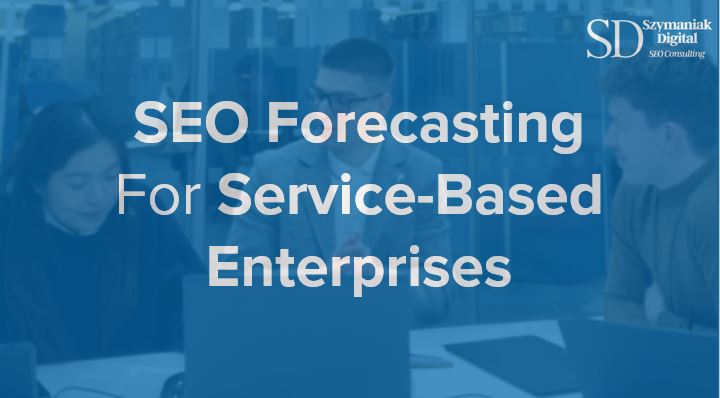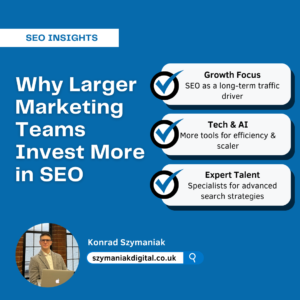SEO Forecasting for Service-Based Businesses
Laying the Foundation for SEO Forecasting
For the purpose of this example, the overarching objective was to determine how many customers a 12-month SEO retainer could bring to this service-based business in the marketing sector. A narrower, more specific objective was to demonstrate the value of SEO by illustrating how much the traffic figures would cost if acquired through a Google Ads campaign.

SEO Forecasting Methodology
The forecasting methodology focused on quantifying common SEO metrics and developing strategies for queries with the highest average monthly search volumes. Data cleaning was conducted using Python in Google Colab, and keywords were further classified into On-Page and Off-Page SEO categories to determine a realistic timeline for achieving specific keyword rankings.
SEO Forecasting Limitations
One limitation of this study was the under-prioritised data collection process. When the data was cleaned, long-tail keywords were excluded to focus on the search volume metric. In real-world practice, such keywords are often queried by users, and their inclusion could enable the site to achieve the forecasted organic search traffic ahead of schedule.
SEO Forecasting for Service-Based Firms: Overview
In overview, Konrad Maksymillian Szymaniak, our founder and “Enterprise SEO Consultant“, proposes a tailored forecast of customer acquisition for the business alongside a well-defined 12-month SEO retainer strategy. This study bridges the theoretical foundations of SEO forecasting with a practice-based approach, offering direct application to real-world business cases.
SEO Forecasting for Service-Based Firms: Future Academic & Professional Bodies Knowledge Exchange Collaborations
We invite readers and the wider audience of both this article and the YouTube video to exchange knowledge and collaborate on similar ideologies in “SEO Forecasting for Service-Based Businesses”.
SEO Forecasting for Service-Based Businesses: YouTube Video
SEO Forecasting for Service-Based Companies: Deeper Dive
Successful SEO forecasting begins with comprehensive data collection. Here are the key metrics to gather:
Keyword Data: Identify search queries, monthly search volumes, and current rankings using SEO tools.
Search Intent: Classify keywords into commercial, navigational, and informational categories.
Keyword Difficulty & SERP Features: Assess the competitiveness of each keyword and note available SERP features, such as local packs and featured snippets.
Cost Per Click (CPC): Calculate how much it would cost to acquire the same traffic through paid search campaigns.
These insights create a data-driven baseline for forecasting traffic growth and assessing SEO’s potential ROI.
Quantifying SEO’s Financial Value via Forecasting
A compelling way to prove SEO’s worth is by comparing it to Google Ads costs. For example:
Current Monthly Traffic: Analyze traffic using tools and estimate the CPC for equivalent paid traffic.
Projected Organic Traffic: Forecast traffic growth by estimating average keyword rankings after 12 months.
Traffic Value: Multiply projected clicks by CPC to showcase cost savings from organic efforts.
For instance, a business spending £3,000 monthly on Google Ads might discover that SEO could deliver equivalent (and sustainable) traffic at a fraction of the cost over time.
Crafting a Strategic SEO Roadmap via Forecasting
Decision Trees for Keyword Prioritisation:
High-difficulty keywords: Allocate them to long-term backlinking strategies.
Low-difficulty keywords: Focus on short-term on-page optimisations.
Timeline Segmentation:
Short-term: Prioritize low-difficulty, high-relevance keywords for immediate gains.
Long-term: Focus on competitive keywords needing authority-building strategies.
Intent-Based Prioritisation:
Commercial keywords often take precedence over informational ones, as they directly impact conversions.
Demonstrating ROI to Stakeholders
Forecasting doesn’t end with traffic projections. Tie traffic to business outcomes:
Lead Generation: Estimate leads by applying a conversion rate to projected traffic.
Customer Growth: Calculate customer numbers using lead-to-customer conversion rates.
Revenue Projections: Multiply customer growth by average customer lifetime value to predict potential revenue (lack of business data allows for customer growth metric for this example).
For a service-based business with a 2% web conversion rate and a 6% lead-to-customer conversion rate, a monthly traffic increase of 273 visitors could translate into 54 leads and 3 new customers each month.
Why SEO Outperforms Paid Search Ads in Longevity
Unlike paid campaigns, SEO delivers lasting benefits. Even if the budget for SEO is reduced, its impact persists longer compared to the immediate halt of paid traffic when ad budgets dry up. This resilience makes SEO a cost-effective and sustainable choice.
Conclusion: SEO Forecasting for Service-Based Businesses
SEO forecasting isn’t just about presenting data; it’s about delivering clarity, value, and confidence. By combining meticulous data analysis with a structured strategic framework, SEO professionals can demonstrate the transformative potential of organic search.
For service-based businesses, this approach not only highlights the cost-efficiency of SEO but also underscores its role in achieving sustainable growth.
Ready to unlock your service-based business’s potential with a tailored SEO Forecast Strategy? Let’s start the conversation today & book an enterprise SEO consultation.

